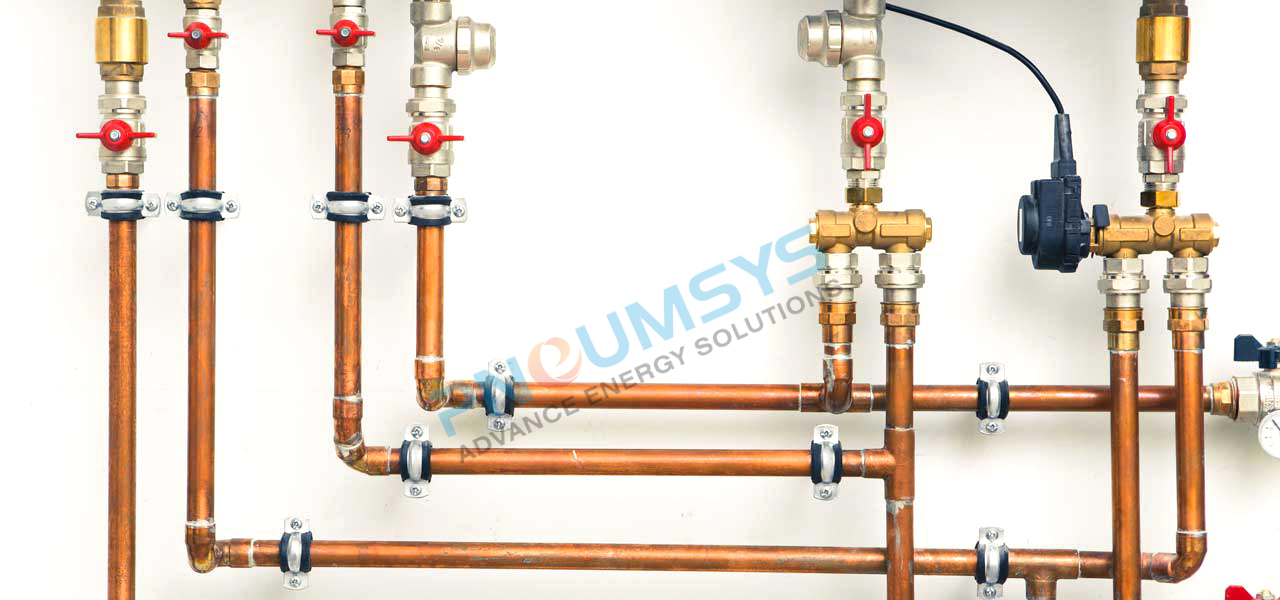
With modern technology has drawn on the unique combination of properties of copper and copper alloys in the form of tube and pipe products, Copper and copper pipeline solutions for fluids or gases is the Ideal Material for Plumbing, Heating, Gas and Renewable Heating and Cooling Applications.
The advanced Copper piping solutions (water and drainage) works in accordance with the American Society of Mechanical Engineers ASME/ANSI standards.
The availability of the wrought and cast copper, and copper alloy pressure fittings is in all standard tube sizes up to 10-inch.
And, the availability of the copper piping solution caters to various need like for plumbing, heating, air conditioning, and fire sprinkler systems. Along with that, the advanced piping solution finds its application in a few colloquial environments like piping infrastructure for drinking water and gas transport.
Probably the most widely-used plumbing material, advanced copper pipeline fitting solution offers the following benefits:
Probably the most widely-used plumbing material, advanced copper pipeline fitting solution offers the following benefits:- Reliable and time-proven: Due to excessive adaptability to the volatility of temperature, it is highly reliable.
- High resistance: It could withstand the volatility of temperatures and pressures and can be exposed to the UV rays, temperature, and oxygen of outside environments.
- Versatile: The Copper tube is used in many products and services: drinking water, home heating (traditional and radiant), gas, medical gases, solar energy systems, fire sprinklers, air conditioning systems.
- It meets the requirements of safety in an unmatched, wide range of temperatures and pressures.
- Energy saving: Kudos to its excellent thermal conductivity property, copper pipes are the best material to exchange heat (or cold fluids). That’s why Copper fitting solutions are the most efficient for radiant heating circuits.
- Recyclable: There is a potential of being recyclable, in case of any unfortunate demolition without loss of performance. As such, the volume of waste at landfill is not increased and the mine resources are not further exploited.
- Healthy: In addition, plumbing tube is made of 99.90% copper, and the composition will not change in time; no additives, volatile organic compounds or pigments are inside it. Beyond that, it is the material of choice for transport of medical gases—like pure oxygen—in hospitals.
- Beautiful: Copper tube can be fitted on the outside of a wall and, thanks to its attractive look, can even be exploited to make beautiful kitchen and bathroom accessories like wall radiators.
- Versatile: Copper tube and advanced copper fitting solutions meet international standards. They are available in various markets and are a vital component of an extensive pipe work framework.
The Details Of the Copper pipeline installation solution Usually, Strength, formability and other mechanical factors often determine the choice. Plumbing and mechanical codes govern what types may be used.
Because of its exceptional formability, copper can be formed as desired at the job site. Copper tube, properly bent, will not collapse on the outside of the bend and will not buckle on the inside of the bend.
Tests demonstrate that the bursting strength of a bent copper tube can actually be greater than it was before bending.
Because copper is readily formed, expansion loops and other bends necessary in an assembly are quickly and simply made if the proper method and equipment are used.
Because copper is readily formed, expansion loops and other bends necessary in an assembly are quickly and simply made if the proper method and equipment are used.
However, the copper tube for underground water services or other underground piping applications can be installed using various installation methods:- Impact moling Specifically, impact moling is a trenchless method for the installation of underground piping or conduit systems. A pneumatic machine connected to a steel piercing head (mole) delivers a surge of air against the mole, which in turn drives the mole through the soil.
- Open trenching Consequently, open trenching is an excavation type of installation for underground piping solutions that have been the industry standard for many years.
- Directional boring or drilling On the top, directional drilling or boring is a process where a wellbore, as they are often referred, can be installed along a given, well-determined lateral distance from vertical or angled starting location. To put it differently, this process is also known as horizontal directional drilling and permits wellbores to be installed along gradual curves as opposed to straight line boring/drilling.
- Direct pulling This is the favorable method for locations and environments where installation of the water service lines will not be affected by low temperatures (freezing) and depth, shallow vibratory direct pulling may be an acceptable option. Also, Soil conditions must be conducive to vibratory plowing.
Certainly, the mole dimension may vary dependent on the tooling being used, but for most cases, the mole diameter is between 1¾” and 2⅜.”
Consequently, open trenching is an excavation type of installation for underground piping solutions that have been the industry standard for many years.
This is the favorable method for locations and environments where installation of the water service lines will not be affected by low temperatures (freezing) and depth, shallow vibratory direct pulling may be an acceptable option. Also, Soil conditions must be conducive to vibratory plowing.
